法律语言及语体特点
法律的语言

法律的语言法律是一种专门用于规范社会行为的语言体系,它包含了一系列的规则、原则和条款,旨在维护社会秩序、保护公民权益,并提供对违法行为的处罚和法律救济。
法律的语言具有一定的特点和规范,下面将对法律语言进行详细的介绍。
首先,法律的语言特点之一是严密性。
法律对事实、权益、责任等概念进行明确而全面的规定,以保证法律的确定性和可执行性。
法律的表述通常使用严谨、精确的措辞,以避免歧义和误解。
例如,在合同法中,法律明确规定了各方的权利和义务,使用了明确的词语和句式,以确保各方按照合同履行自己的责任。
其次,法律的语言特点之二是正式性。
法律作为一种具有法律效力的文书,其语言表达需要符合一定的规范和格式。
法律文书通常采用正式的语言,使用规范的词汇和句式,以确保法律的权威性和可信度。
法律文书中常见的格式包括标题、条款、定义等,这些格式的使用使得法律表述更加明确和易于理解。
第三,法律的语言特点之三是技术性。
法律涉及到许多专业领域的知识和术语,例如民法、刑法等,因此,它的表述中常常包含专业性较强的术语和定义。
法律语言的技术性使得它在某种程度上对于非法律专业人士来说可能会比较晦涩和难懂,因此在法律文书的表述中需要考虑到目标读者的背景和水平。
此外,法律的语言还需要具备灵活性。
法律适用于各种不同的情况和问题,因此其表述需要具备一定的灵活性,能够适应不同的法律要求和需求。
例如,在解释法律条款时,常常需要根据具体的情况进行解析和诠释,以保证法律的具体适用性。
最后,法律的语言还需要具备可理解性。
法律的表述应该尽可能简洁明了,以确保任何人都能够理解和遵守法律规定。
法律应该以通俗易懂的方式表达,避免使用过于复杂和晦涩的词汇和句式,以便公众能够理解其中的内容和要求。
综上所述,法律的语言是一种严密、正式、技术性、灵活和可理解的语言。
法律的语言特点是为了确保法律的确定性、权威性和可执行性,保障公民权益、维护社会秩序。
对于从事法律工作的人员来说,理解和运用法律的语言是十分重要的,只有掌握了法律的语言,才能更好地履行法律职责。
法律英语的特点
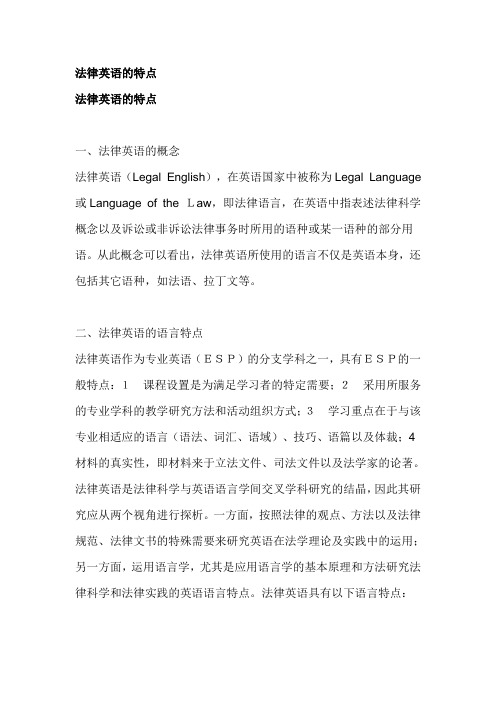
法律英语的特点法律英语的特点一、法律英语的概念法律英语(Legal English),在英语国家中被称为Legal Language 或Language of the Law,即法律语言,在英语中指表述法律科学概念以及诉讼或非诉讼法律事务时所用的语种或某一语种的部分用语。
从此概念可以看出,法律英语所使用的语言不仅是英语本身,还包括其它语种,如法语、拉丁文等。
二、法律英语的语言特点法律英语作为专业英语(ESP)的分支学科之一,具有ESP的一般特点:1课程设置是为满足学习者的特定需要;2采用所服务的专业学科的教学研究方法和活动组织方式;3学习重点在于与该专业相适应的语言(语法、词汇、语域)、技巧、语篇以及体裁;4 材料的真实性,即材料来于立法文件、司法文件以及法学家的论著。
法律英语是法律科学与英语语言学间交叉学科研究的结晶,因此其研究应从两个视角进行探析。
一方面,按照法律的观点、方法以及法律规范、法律文书的特殊需要来研究英语在法学理论及实践中的运用;另一方面,运用语言学,尤其是应用语言学的基本原理和方法研究法律科学和法律实践的英语语言特点。
法律英语具有以下语言特点:词汇特点一、准确用词与模糊语言的同时出现法律语言,尤其是立法语言常把准确性与模糊性这一矛盾纳入同一法律规范。
根据严格解释原则,在适用法律时,书面文字是法官解释法律文件的唯一依据,因此法律语言用词造句必须十分准确。
法律语言尤其是立法语言中很少使用描绘性形容词,而且对表示时间、范围、程度等副词使用极为严格,为了避免不必要的歧义。
同时,为了追求语意确切、论证周详,法律语言中常使用同义、近义词,如《香港刑法摘要》(D igest of Hong Kong Criminal Law)第八章关于“参加暴动并阻碍船舶、飞机、或者铁路列车罪”中规定“It is an offence for any perso n taking part in a riot to unlawfully and with force (a)prevent , hinder or obstruct ,or attempt to prevent, hinder, or obstruct, t he loading or unloading, or the movement of ; or (b)board, or attempt to board with intent to do so ; any motor vehicle ,tra mcar ,aircraft ,train or vessel . 然而在现实中,有许多案子是由于对法律文字的理解不一造成的,这就有赖于法官在具体案件中对法律条文进行解释。
法律语言特点的辩证体现
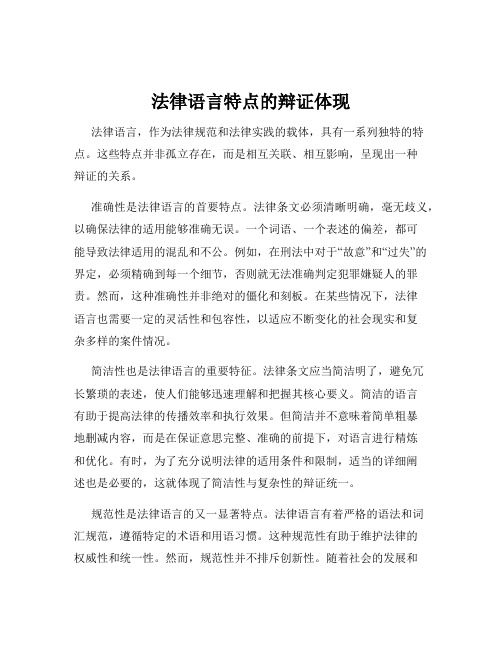
法律语言特点的辩证体现法律语言,作为法律规范和法律实践的载体,具有一系列独特的特点。
这些特点并非孤立存在,而是相互关联、相互影响,呈现出一种辩证的关系。
准确性是法律语言的首要特点。
法律条文必须清晰明确,毫无歧义,以确保法律的适用能够准确无误。
一个词语、一个表述的偏差,都可能导致法律适用的混乱和不公。
例如,在刑法中对于“故意”和“过失”的界定,必须精确到每一个细节,否则就无法准确判定犯罪嫌疑人的罪责。
然而,这种准确性并非绝对的僵化和刻板。
在某些情况下,法律语言也需要一定的灵活性和包容性,以适应不断变化的社会现实和复杂多样的案件情况。
简洁性也是法律语言的重要特征。
法律条文应当简洁明了,避免冗长繁琐的表述,使人们能够迅速理解和把握其核心要义。
简洁的语言有助于提高法律的传播效率和执行效果。
但简洁并不意味着简单粗暴地删减内容,而是在保证意思完整、准确的前提下,对语言进行精炼和优化。
有时,为了充分说明法律的适用条件和限制,适当的详细阐述也是必要的,这就体现了简洁性与复杂性的辩证统一。
规范性是法律语言的又一显著特点。
法律语言有着严格的语法和词汇规范,遵循特定的术语和用语习惯。
这种规范性有助于维护法律的权威性和统一性。
然而,规范性并不排斥创新性。
随着社会的发展和法律实践的丰富,新的法律概念和术语不断涌现,法律语言也在不断发展和创新,以适应新的法律需求。
法律语言的专业性很强,它包含大量的专业术语和法律概念,这些术语和概念对于法律从业者来说是熟悉和准确的,但对于普通民众可能会显得晦涩难懂。
这就需要在专业性和通俗性之间找到平衡。
一方面,法律语言必须保持其专业性,以确保法律的严谨和精确;另一方面,为了让民众更好地理解法律、遵守法律,法律语言也应当尽量通俗易懂,通过解释、说明等方式,将专业术语转化为大众能够理解的语言。
法律语言的逻辑性也十分突出。
它遵循严密的逻辑推理和论证过程,从前提到结论,每一个环节都必须经得起推敲。
逻辑的严密性保证了法律的公正性和可预测性。
浅议立法语言的特点和表述问题

浅议立法语言的特点和表述问题作者:李高协来源:《人大研究》 2015年第1期法律条文是由语言文字表达出来的,它表达的是一种国家意志,文字表达得是否清楚、规范,直接影响着立法质量甚至实施效果。
李高协法律条文是由语言文字表达出来的,它表达的是一种国家意志,文字表达得是否清楚、规范,直接影响着立法质量甚至实施效果。
本文根据有关立法语言的规范要求和研究成果,结合自己多年从事地方立法的实践,主要针对在立法工作中经常遇到的、带有共性和普遍性的有关立法语言的特点与文字表述等技术操作层面的问题谈一些体会,仅供交流和探讨。
一、立法语言的基本特点和要求立法语言简单地讲就是规范性法律文件所使用的语言,是具有法律效力的法律信息载体。
法律作为具有国家强制力的普遍性行为规则的特性,要求其语言表达尽量保持日常语言的风格以便使普通民众所理解和遵循。
同时,对立法语言又有其特殊的要求,比如准确肯定、严谨规范、简洁精练、庄重严肃、通俗易懂。
英国著名的法理学家边沁在他的《立法理论》中说:“如果说法典的风格与其他著作的风格有什么不同的话,那就是具有更大的清晰性、更大的精确性、更大的常见性。
因为它写出来就是让所有人都理解,尤其是让最低文化水平阶层的人理解。
”文艺复兴时期著名的哲学家培根也讲,法律文辞一要准确,二要有弹力性。
我国历史上的一些政治家、法学家也主张立法语言应简明扼要、易晓知行。
秦商鞅说:“圣人为法,必使之明白易知。
”唐太宗李世民讲:“国家法令,惟须简约。
”(一)立法语言要符合国家语言文字的规范和标准。
法律条文表达的是一种国家意志,首先应当符合通用语言文字的规范和标准,使用规范的书面语言。
立法语言和文学语言、文件语言、口头语言不同,应当具体明确、简洁精练,避免使用夸张、比喻以及带有感情色彩的修饰性语言,避免使用宣言性、论述性语言。
句式应当完整、明确,符合语法规范,词语搭配合理,避免使用长句。
立法也不用严禁、严格、严厉这类带有主观意愿的形容词,这些词可以用在执法上,但不能用于立法上。
法律语言及语体特点

Linguistic and Stylistic Features of Legal English in T ranslationAbstractWith the quickening process of globalization of the world economy and after China‟s WTO accession, legal English, as a kind of professional English, is progressing rapidly in our country which is surely having more links with other countries in the world. Undoubtedly, there will be more and more legal documents that need to be translated. Legal English is a particular expressing mode and criterion formed gradually developed through a long process of judicial practice. To do well in the translation of English in law, it is crucial to understand its features. It has vivid features in words diction and sentence structure, and embodies the specialty, sobriety, preciseness and veracity of the legal language .This paper, from the point of linguistics and stylistics, analyses the present situation of legal English, elaborates the features of English in translation of legal documents and summarizes its major stylistic features: accuracy, vagueness and speciality. It reiterates the idea that translation of legal documents requires the grasp of its linguistic features so it also explores those linguistic features in a systematic way .Key words: linguistic featuresstylistic featureslegal Englishtranslation.1.Introduction“Legislative writing has acquired a certain degree of Notoriety rarely equaled by any other variety of English. It has long been criticized for its obscure expressions and circumlocutions,long-winded involved construction and tortuous syntax,meaningless repetitions and archaisms. To the specialist community these are indispensable linguistic devices which bring in precision,clarity,unambiguity and all- inc lusiveness and so on. However,to the non-specialist this is a mere ploy to promote solidarity between the members of the specialist community and to keepnon-specialists at a respectable distance and is hence regarded by them as nothing more than pure linguistic nonsense bringing into professional discourse pomposity, verbosity, flabbiness and circumlocution.”(Bhatia,1994:136)This is a judgement given by Vijay Bhatia about the linguistic features of legislative writings in the first paragraph of his works Cognitive Structuring in Legislative Provisions. It talks about both the specific and unique lexical and syntactic features of the legislative text and also how these linguistic features count from the specialists and non-specialists perspectives. In recent years,there has been a continual process of simplification of the legislative language in the English-speaking countries.However, despite these efforts at simplification and clarification, the gap between legislative text and everyday text is still very wide. Present day legislative text retains its identity as a highly specialized and distinctive text type or genre of English. The legislative texts of the legal systemsof England, Canada, the United States of America, Australia and New Zealand, which are derived from the English common law system, are manifestly similar. (Maley,1994:13) And now, deliberate discussion on the lexical as well as syntactic features of the legislative language will be given in the following part with an aim to guide the translation of this type of legal texts.2.Lexical Features of Legal EnglishArchaic relics,including archaism,French and Latin expressions,are retained in English legislative texts to achieve precision. Also,it is there out of the convention left by the long history of English law. The institution of English law dated from the Norman Conquest. The Normans brought with them legal concepts and procedures,and thus the institution was established. The written language of the law after the Conquest was at first Latin and English. Later,Latin gained ground steadily and became the predominant language in law. And the Latin then in the institution,was not classical or Medieval Latin,but a variety of Latin which included many Latinizied English and Old French words. By the fourteenth century,French became the language of law. And it is not until 1650,by An Act for Turning the Books of the Law,and all processes and proceedings in Courts of Justice into English(455(1650) 11 Acts and Ordinances or the Interregnum) that English became the official language of the law. By that time,Old English(archaism),Latin,Nomran-French and Middle English terms got fixed in the vocabulary of law. Over the cenutries,there has been a continual process Anglicisation,but in vocabulary,particularly in the specialized,technical lexicon,the law,the effect of its varied origins is still apparent. (Maley,1994:11-13) And now,let‟s see some of the archaisms, words with Latin and French origins, technical terms and official words retained in the legislative texts.ArchaismFrequent use of archaic words is one of the most remarkable featuers of legal language. Archaisms are the set of words used in the period 450-1100 AD,and the period 1100-1500 AD (Li,2003:17) and seldom appear in modern English,especially in the modern oral English. But they do remain in the legislative texts in light of the correctness and conservation of legislative language. Mellinkoff gave some archaisms that he considered to be the“daily bread”for the lawyers and“exposed to most non-lawyers on infrequent occasions”(1963:13): aforesaid and forthwithhere words: hereafter,herein,hereof,heretofore,herewithlet,as in the law tautology,without let or hindrancesaid and such as adjectivesthere words: thereabout, thereafter, thereat, thereby, therefore, therein, thereon, thereto, theretofore, thereupon, therewithwherewords, especially whereas used in recitals, and whereby witness, in the sense of testimony by signature, oath, etc., as in “ In witness whereof, I have set my hand, etc.”witnesseth, meaning to furnish formal evidence of something, the Old English present indicative, third person singular verb form.These words help ensure the accuracy and formalness of the legal texts.Loan wordsWith the expansion of international exchanges and the accelerated trends of globalization,acountry will more or less be influenced by the outside world, so wll the language of the nation. The borrowing of“loan words” is a process in which both form and meaning are borrowed with only a slight adaptation to the phonological system of the new language in some cases. Legal English has used some words that have been borrowed from Latin,French,etc.Words with Latin originLatin first permeated into English in 597 AD,and intermingled by large amount with English in the field of law,in the archaism period of the 14th and 15th AD (Li,2003:17). And since then,lots of English words with Latin sources remain in legal English,some of which are listed in the following table:affirm(断言) veto(否决)appeal(上诉) immune(免除的)offence(犯罪) verdiet(裁决)injury(伤害) litigant(诉讼人)legal(合法的) register(注册)custody(拘留) orbiter(仲裁人)suppress(镇压) testimony(证词)detention(拘留) negotiate(谈判)homicide(杀人) Convict(宣告)declaration(宣言) prosecute(对…起诉)compensate(补偿) appellate(受理上诉的) There are also Latin words retained in the legislative texts. Here is a list of Latin words basic to legislative texts:jus retentiouis(留置权) per stirpes(代位继承)obligatio solidaria(连带债务) confide jussio(共同保证)words with French originSince 1154,Britain had been reined by France in the House of Plantagenet and French became the official language,widely used in palace, courts and schools. Lots of English words with French origins are reserved in the legislative texts today,such as:bill(法案) petition(请愿)suit(诉讼) summon(传票)plea(抗辩) eyre(巡回法庭)inquest(审讯) defendant(被告)assize(巡回审判) attorney(律师)complaint(控告) advocate(辩护者)plaintiff(原告) judge(审判员,法官)bar(法庭,审判台) hue and cry(通缉令)indictment(告发,控告)Technical termsLots of legal technical terms are used in legislative texts out of the requirement for the correctness and clearness of the legal concept. And there are usually two kinds of technical terms in legislative language: the first type is technical terms employed to express the concept ofcommon-core language in daily life; the second type is common-core vocabulary in daily life borrowed to define specific legal meanings in legal language. The former includes words like: tort(侵权) subrogation(代位权)certiorari(上级法院向下级法院或准司法机构调取案卷的令状),while the latter contains the words like:average(海损) minor(未成年人)omission(不作为) review(复审)limitation(诉讼实效) precedent(判例,先例)affirmance(上级法院维持对下级法院的判决)official wordsColloquial language is seldom used in legislative texts,and aggregation of big words and written language is one of the characteristics of legislative texts.There are many examples to demonstrate this point:Terminated-end purchase-buyRender-make proceed-gorequest-task prior-earlierdesist-stop employ-useamiable-friendly present-givedemonstrate-show commence-beginThe words on the left side of these groups are official words used in legislative texts,while the words on the right side of these groups having exact meanings with the words on the left,but being more colloquial and informal words used more in daily language.Use of synonymsAs the function of legislation is conferring rights and imposing obligations, the use of synonyms helps make the denotation clearer and more precise. Generally speaking,synonyms cannot be replaced by each other in legal English. The difference between“misstatement”and “misrepresentation” is a good illustration of this point. For example,the directors of a company invited a loan from the public and stated that the money would be used to improve the comp any‟s buildings and to extend the business. The real intention of the directors was to use the money to pay off the comp any‟s debts.In this case,is the statement of the directors to the public called “misstatement”or “misrepresentation”? It depends on the fact whether or not the public has made a contract with the company. If so,“mispresentation”should be used. If not,“misstatement”should be used instead.3.Syntactic Features of Legal EnglishBesides lexicon,the syntactic structure of the legislative language is also unique. Unlike syntactic structures in other texts, complex-prepositions, binomial and multinomial expressions, nominalization,a large number and variety of qualifications are used in legislative texts. “The reason for this complexity appears to be that legislative is often trying to cover all possible combinations of conditions and contingencies. Language complexity increases greatly when an attempt is made to unify all these within the confines of a single sentence.”(John,1994:7) These Complicated syntactic features create barriers to effective understanding of legislative texts,yetgreatly to the clear,unambiguous and all-inclusive features of legislative texts. The following are syntactic features of legislative texts.3.1 Use of long complicated sentencesIn order to avoid misunderstandings and disputes,legal drafts sometimes have to arrange a lot of relevant information in different respects into the same sentence,thereby producing a prevalent phenomenon of long complicated sentences in legal texts. It is common to see a passage or an article that contains only one sentence,which asks for the legal translators‟logical and clear understanding of all constituents of the sentence. Sometimes it is up to legal translators to put the long complicated sentences into compound sentences with objective clauses, adverbial clauses or attributive clauses for a well-ogranized and clear statement. Look at the follownig examples:1)Chinese Original V ersion:第二十四条国家基于下列原因之一,可以限制国际服务贸易:(一) 为维护国家安全或者社会公共利益;(二)为保护生态环境;(三)为建立或者加快建立国内特定的服务行业;(四)为保障国家外汇收支平衡;(五)法律、行政法规规定的其他限制。
试析法律英语的词汇特点
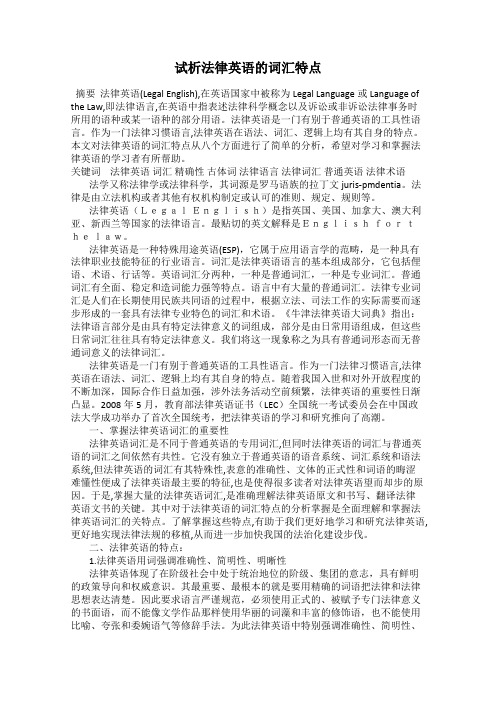
试析法律英语的词汇特点摘要法律英语(Legal English),在英语国家中被称为Legal Language或Language of the Law,即法律语言,在英语中指表述法律科学概念以及诉讼或非诉讼法律事务时所用的语种或某一语种的部分用语。
法律英语是一门有别于普通英语的工具性语言。
作为一门法律习惯语言,法律英语在语法、词汇、逻辑上均有其自身的特点。
本文对法律英语的词汇特点从八个方面进行了简单的分析,希望对学习和掌握法律英语的学习者有所帮助。
关键词法律英语词汇精确性古体词法律语言法律词汇普通英语法律术语法学又称法律学或法律科学,其词源是罗马语族的拉丁文juris-pmdentia。
法律是由立法机构或者其他有权机构制定或认可的准则、规定、规则等。
法律英语(LegalEnglish)是指英国、美国、加拿大、澳大利亚、新西兰等国家的法律语言。
最贴切的英文解释是Englishforthelaw。
法律英语是一种特殊用途英语(ESP),它属于应用语言学的范畴,是一种具有法律职业技能特征的行业语言。
词汇是法律英语语言的基本组成部分,它包括俚语、术语、行话等。
英语词汇分两种,一种是普通词汇,一种是专业词汇。
普通词汇有全面、稳定和造词能力强等特点。
语言中有大量的普通词汇。
法律专业词汇是人们在长期使用民族共同语的过程中,根据立法、司法工作的实际需要而逐步形成的一套具有法律专业特色的词汇和术语。
《牛津法律英语大词典》指出:法律语言部分是由具有特定法律意义的词组成,部分是由日常用语组成,但这些日常词汇往往具有特定法律意义。
我们将这一现象称之为具有普通词形态而无普通词意义的法律词汇。
法律英语是一门有别于普通英语的工具性语言。
作为一门法律习惯语言,法律英语在语法、词汇、逻辑上均有其自身的特点。
随着我国入世和对外开放程度的不断加深,国际合作日益加强,涉外法务活动空前频繁,法律英语的重要性日渐凸显。
2008年5月,教育部法律英语证书(LEC)全国统一考试委员会在中国政法大学成功举办了首次全国统考,把法律英语的学习和研究推向了高潮。
法律合同的语体特征及翻译原则探究

法律合同的语体特征及翻译原则探究法律合同是合法双方达成协议,并确定了各自权利和义务的书面文件。
其语言应该精准、明确,不能存在歧义或模糊的表述,因此其语体特征也是非常独特的。
本文将探究法律合同的语体特征以及翻译原则。
一、语体特征1.正式严谨法律合同所使用的语言应该是正式、严谨的,不能使用口语化的语言或俚语,也不能使用含义模糊的词语,如“大概”、“大约”等。
在法律合同中,一些含义具有争议的词语通常会被定义,以确保各方对于合同条款的理解一致。
2.第三人称法律合同中通常以第三人称进行表述,避免出现过多的主观性。
3.被动语态法律合同中大量使用被动语态,以表达被动、客观的含义。
4.繁琐冗长为了避免出现歧义,法律合同通常会尽可能详细地描述合同内容,使得合同内容较为繁琐冗长。
5.技术性强法律合同中出现了很多法律术语和专业语言,双方需要具备一定的法律常识才能够准确地理解合同内容。
二、翻译原则1.忠实原文翻译法律合同时,应该要求译者保持忠实原文的原则,即字面翻译,不得添加任何误译、漏译或加译内容。
2.专业术语正确翻译在翻译法律合同时,需要特别注意法律术语和专业词汇的翻译准确性,必须准确地表达原文中的含义。
3.精准、明确在翻译法律合同时,应保持翻译文本的精准和明确性,不能出现歧义或模糊表述。
4.避免过多主观性译者在翻译法律合同时需要尽可能避免使用过多主观性的语言,尽可能使用客观、被动语态的表述。
5.注意语言风格在翻译法律合同时,需要特别注意语言风格,避免使用口语化语言或俚语。
6.追求精益求精翻译法律合同时,需要不断完善自己的翻译技能和专业知识,追求精益求精,提高法律合同翻译的质量。
试论法律文书语言的特点

试论法律文书语言的特点马克思说:“语言是思想的直接现实”,古人亦云“言为心声”。
文章的思想内容是要通过语言这一特定的形式来表达的,而语言运用能力的强弱直接关系到文章的成败与优劣。
作为具体实施法律工具的法律文书对语言的要求则更加严格,它的语言呈现出有别于其他文字材料的鲜明特点。
一、语言的准确所谓语言准确,是指所使用的概念和判断能正确地反映事物的本质。
语言准确是对一切文章的最基本要求,也是法律文书的最显著、最重要的特点,是法律文书的生命。
法律文书的内容往往涉及到当事人的生杀予夺或一生的福祸荣辱,关系到法律的正确实施。
因此,法律文书中无论是对当事人身份事项的说明,还是对案件事实的叙述,无论是依据事实、法学理论阐明论证适用法律的正确,还是表明对案件的处理结果,都必须做到语言的准确,而不能含糊其辞,似是而非,语义两歧。
具体应注意以下几点。
1.词语要注意单义性。
内容的法律性要求法律文书的语言必须具备单义性的特点。
所谓单义性是指一定的词语必须表示特指的含义,适于此而绝不同时适于彼,也就是对词语的解释是唯一的。
法律文书词语的单义性主要体现在专业术语的单义性上。
专业术语的单义性决定了对术语解释的严谨周密,理解的角度单一以及含义的确定,避免了误解和歧义。
比如“罚金”和“罚款”,从词的构成上看,都是动宾式合成词,构词形式相同,在日常生活用语中,二者区别也不大,但作为法律术语,二者却有着本质区别,各有特定的含义,是两个截然不同的法律概念,在任何情况下都不能互相代替,混淆使用。
此外,“审查”“侦查”和“审理”,“抢劫”和“抢夺”,“讯问”和“询问”等都有着不同的内涵,不可混用。
2.选用近义词要恰当。
有些近义词基本含义相同,但适用对象有别,若不区分其细微差别而恰当使用,会造成概念不明确。
如“抚养、扶养、赡养”都有养活的意思,但适用对象不同,我国《宪法》第四十九条规定:“父母有抚养教育未成年子女的义务,成年子女有赡养扶助父母的义务。
法律英语的语言特点浅析教育论文

法律英语的语言特点浅析教育论文[摘要]法律英语是一种具有法律专业特点的语言。
法律英语就其文体来说属于职业专用英语(English for Oupational Purposes),是一种正式的书面语体,以行文庄重、构造严谨、表达准确为其特点。
为了熟练掌握和运用法律英语,必须首先了解法律英语的语言特点。
本文主要从词汇、句法和文体三个方面分析了法律英语的语言特点。
[关键词]法律英语词汇句法1.含有法律专业意义的普通词汇随着世界经济的全球化,法律英语作为一种行业英语正在中国迅速开展起来。
法律英语是经过长期的司法实践逐步形成的有独特的表达模式和标准,它在词汇用语、句法构造上具有鲜明的特点,表达了法律语言的专业性、庄重性、严谨性和准确性。
法律英语和普通英语的重要区别之一就是法律英语中用到的很多普通词汇往往具有专业特定含义。
例如:dominion在民法中指完全所有权,在国际公法中那么为主权;estoppel在合同法中是不得反悔,在刑事讼诉法中那么是制止翻供。
因此,法律英语有其特定的法律上的意义与效果,不可随便改变形式。
2.特定的法律专业术语法律法规的标准调节作用主要是通过具有法律效果的言语行为,即法律言语行为来实现的。
因此,作为言语行为实施者的立法者和司法者的法律能力和语言能力主要特点之一就是准确得体地使用法律言语,以便能够传达其所意图的法律效果。
正是法律语言的特殊社会功能使法律语言成为表达特有法律概念的专门术语。
如plaintiff(原告),defendant(被告),bigamy(重罪),demurrer(抗辩)等,这些术语具有法律语言的典型文体特点,通常不会在其他语域中出现。
3.外来词英语词汇的绝大局部都法语与拉丁语。
法语对英语的影响极其深远,法律英语当然也不例外。
例如:bar(法庭判台),verdict(裁决)等。
当代法律英语的根底是普通法,普通法的根底是中世纪的罗马教会施行的罗马法,而罗马法是拉丁文写成和实施的,故当今的法律英语中留下许多拉丁词缺乏为奇,例如:alibi(某人不在犯罪现场的申辩或),declaration(申诉,陈述,证言)。
法律英语的文体特点及英译技巧
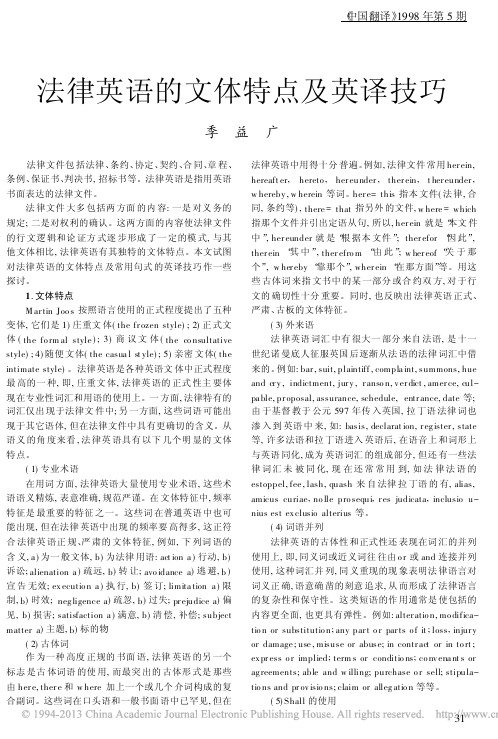
法律英语的文体特点及英译技巧季 益 广 法律文件包括法律、条约、协定、契约、合同、章程、条例、保证书、判决书,招标书等。
法律英语是指用英语书面表达的法律文件。
法律文件大多包括两方面的内容:一是对义务的规定;二是对权利的确认。
这两方面的内容使法律文件的行文逻辑和论证方式逐步形成了一定的模式,与其他文体相比,法律英语有其独特的文体特点。
本文试图对法律英语的文体特点及常用句式的英译技巧作一些探讨。
1.文体特点M ar tin Joo s按照语言使用的正式程度提出了五种变体,它们是1)庄重文体(the fr ozen style);2)正式文体(the fo rm al style);3)商议文体(the co nsultative style);4)随便文体(the casua l st yle);5)亲密文体(the intimate style)。
法律英语是各种英语文体中正式程度最高的一种,即,庄重文体,法律英语的正式性主要体现在专业性词汇和用语的使用上。
一方面,法律特有的词汇仅出现于法律文件中;另一方面,这些词语可能出现于其它语体,但在法律文件中具有更确切的含义。
从语义的角度来看,法律英语具有以下几个明显的文体特点。
(1)专业术语在用词方面,法律英语大量使用专业术语,这些术语语义精炼,表意准确,规范严谨。
在文体特征中,频率特征是最重要的特征之一。
这些词在普通英语中也可能出现,但在法律英语中出现的频率要高得多,这正符合法律英语正规、严肃的文体特征,例如,下列词语的含义,a)为一般文体,b)为法律用语:act ion a)行动,b)诉讼;alienation a)疏远,b)转让;avo idance a)逃避,b)宣告无效;ex ecutio n a)执行,b)签订;limita tion a)限制,b)时效;neg ligence a)疏忽,b)过失;pr ejudice a)偏见,b)损害;satisfaction a)满意,b)清偿,补偿;subject matter a)主题,b)标的物(2)古体词作为一种高度正规的书面语,法律英语的另一个标志是古体词语的使用,而最突出的古体形式是那些由her e,ther e和w here加上一个或几个介词构成的复合副词。
法律语言的特点及法律翻译
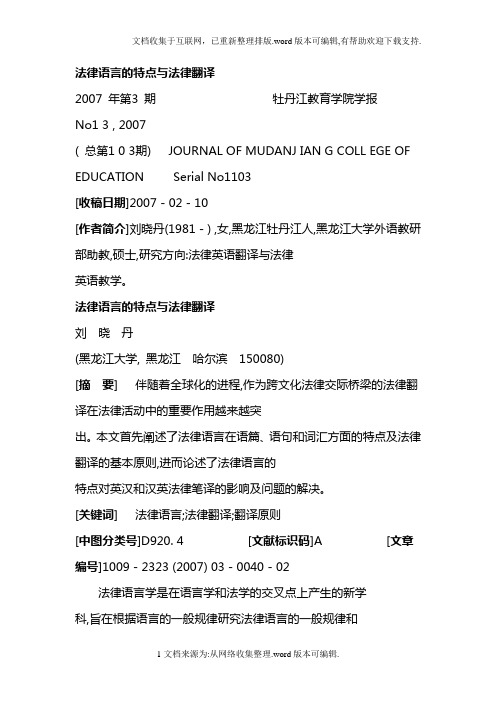
法律语言的特点与法律翻译2007 年第3 期牡丹江教育学院学报No1 3 , 2007( 总第1 0 3期) JOURNAL OF MUDANJ IAN G COLL EGE OF EDUCATION Serial No1103[收稿日期]2007 - 02 - 10[作者简介]刘晓丹(1981 - ) ,女,黑龙江牡丹江人,黑龙江大学外语教研部助教,硕士,研究方向:法律英语翻译与法律英语教学。
法律语言的特点与法律翻译刘晓丹(黑龙江大学, 黑龙江哈尔滨150080)[摘要] 伴随着全球化的进程,作为跨文化法律交际桥梁的法律翻译在法律活动中的重要作用越来越突出。
本文首先阐述了法律语言在语篇、语句和词汇方面的特点及法律翻译的基本原则,进而论述了法律语言的特点对英汉和汉英法律笔译的影响及问题的解决。
[关键词] 法律语言;法律翻译;翻译原则[中图分类号]D920. 4 [文献标识码]A [文章编号]1009 - 2323 (2007) 03 - 0040 - 02法律语言学是在语言学和法学的交叉点上产生的新学科,旨在根据语言的一般规律研究法律语言的一般规律和特殊性。
[1 ] 法律翻译作为法律语言学研究的主要内容之一, 包括口译和笔译。
伴随着全球化的进程,作为跨文化法律交际桥梁的法律翻译,在法律活动中的重要作用越来越突出。
法律翻译由于其自身的特性,必然受制于法律语言本身的特点。
因此,法律翻译中与法律语言相关问题的研究和解决必将有利于提高翻译的质量。
一、法律语言的特点法律学科本身的特殊性以及法律长期在人们的政治、经济、科学和文化生活中所发挥的强大的规范和调节作用, 使得法律语言在实现其调节、规范作用的过程中也形成了一些自身的语体特点。
法律语言的使用特点可以从语篇结构、句法选择和词汇使用三个层面来考察。
1. 语篇结构特点从语篇结构层面上看,法律语篇最突出的特点是它的高度程式化。
语篇指超过一句话或超过一个句子的口语或书面语言的连续体,是话段或句子构成的语言整体。
法律文书的语言特点(3篇)
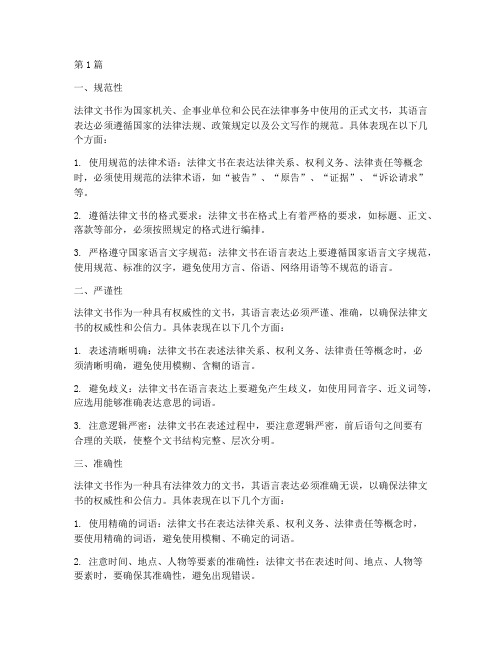
第1篇一、规范性法律文书作为国家机关、企事业单位和公民在法律事务中使用的正式文书,其语言表达必须遵循国家的法律法规、政策规定以及公文写作的规范。
具体表现在以下几个方面:1. 使用规范的法律术语:法律文书在表达法律关系、权利义务、法律责任等概念时,必须使用规范的法律术语,如“被告”、“原告”、“证据”、“诉讼请求”等。
2. 遵循法律文书的格式要求:法律文书在格式上有着严格的要求,如标题、正文、落款等部分,必须按照规定的格式进行编排。
3. 严格遵守国家语言文字规范:法律文书在语言表达上要遵循国家语言文字规范,使用规范、标准的汉字,避免使用方言、俗语、网络用语等不规范的语言。
二、严谨性法律文书作为一种具有权威性的文书,其语言表达必须严谨、准确,以确保法律文书的权威性和公信力。
具体表现在以下几个方面:1. 表述清晰明确:法律文书在表述法律关系、权利义务、法律责任等概念时,必须清晰明确,避免使用模糊、含糊的语言。
2. 避免歧义:法律文书在语言表达上要避免产生歧义,如使用同音字、近义词等,应选用能够准确表达意思的词语。
3. 注意逻辑严密:法律文书在表述过程中,要注意逻辑严密,前后语句之间要有合理的关联,使整个文书结构完整、层次分明。
三、准确性法律文书作为一种具有法律效力的文书,其语言表达必须准确无误,以确保法律文书的权威性和公信力。
具体表现在以下几个方面:1. 使用精确的词语:法律文书在表达法律关系、权利义务、法律责任等概念时,要使用精确的词语,避免使用模糊、不确定的词语。
2. 注意时间、地点、人物等要素的准确性:法律文书在表述时间、地点、人物等要素时,要确保其准确性,避免出现错误。
3. 严谨使用数字和符号:法律文书在表述数字、符号等时,要确保其准确无误,避免出现错误。
四、简洁性法律文书作为一种具有严谨性的文体,其语言表达要简洁明了,避免冗长、繁琐。
具体表现在以下几个方面:1. 使用简洁的语句:法律文书在表述法律关系、权利义务、法律责任等概念时,要使用简洁的语句,避免使用冗长、复杂的句子。
法律英语术语的分类及语言特点法律,英语,语言.doc

法律英语术语的分类及语言特点-法律,英语,语言-商务指南-法律英语专门术语是用来准确表达特有的法律概念的专门用语。
这类专门用语既有和其它各类术语相同的共性,也有其自己特有的个性。
根据意义结构或语义范围,这类专门用语可分为常用术语、排他性专门涵义术语、专门法律术语和借用术语四种形式。
1.常用术语法律英语常用术语有两种概念:第一,不明确表示特定的法律概念,语域比较广,既常用于法律语言中,也是社会日常生活各方面不可缺少的词语,在两种语域中无语义差别,而且通俗易懂。
例如:conduct(行为),write(签字),witness(证明),goods(商品),individual(个人),sum(总额),signing (签署),insurance(保险),gambling(赌博),rule(规则),marriage(婚姻),divorce(离婚)等等。
第二,表示特定的法律概念,但是随着应用范围的扩大和全民词汇发生密切联系而经常互相交换与影响,结果由原来只有法律工作知晓的术语扩伸到全民词汇领域中。
例如:law(法律),lawyer(律师),debt(债务),murder(谋杀),crime(罪行),prison(监狱),court(法庭),contract(合同),police(警察),will(遗嘱),fine(罚款),punishment (惩罚),sentence(判决),judgement(审判),robbery(抢劫),theft(偷窃)等等。
随着法律知识的普及和法制的发展,这类术语全民化的数量会不断加大。
法律英语常用术语由于法律和全民通用,所以其最大特点就是常用性及适用场合广。
据此,这类术语一般文体信息较少,具有中性文体意义效果。
另外由于这类术语都是常用词,所以其构词能力较强,如law lawful和lawyer,crime criminal,contract contractual,而且有的具有多义性,应用时要注意词形变化和语境。
法律语言学探讨法律语言的特点和解释方法

法律语言学探讨法律语言的特点和解释方法法律语言是一种具有特殊性质和功能的语言形式,它在法律领域中担当着重要的角色。
本文将探讨法律语言的特点以及解释方法。
一、法律语言的特点1. 精确性法律语言要求精确性,即法律的表述不能模棱两可、含糊不清。
为了实现精确性,法律语言经常采用明确定义的术语,通过精确的措辞来确保法律条款的准确传达和适用。
2. 抽象性法律语言具有一定的抽象性,即它往往运用抽象的概念来描述法律关系、权利义务等。
这种抽象性使得法律语言可以用于适应各种具体情况,不受特定情境的限制。
3. 正式性法律语言具有正式性,即在法律文本中采用一定的词汇、语法和用法,以使其具备法律效力。
正式性能够增加法律条文的权威性,并使得法律规则达到一定的稳定性和可预测性。
4. 约束力法律语言必须具备一定的约束力,它能够直接约束公民的行为或产生特定的法律效果。
法律语言的约束力不仅来源于其明确定义的条文,还来源于法律体系的权威性和公众的认可。
二、解释法律语言的方法1. 文本解释法文本解释法是最常见的法律条文解释方法,它强调依据法律文本的字面意义进行解释。
这种方法尊重条文的表述,避免对法律文本的主观解读,并确保法律的稳定性和可预测性。
文本解释法适用于法律语言表达明确、法律关系清晰的情况。
2. 法理解释法法理解释法强调对法律条文的理性解释,在解释法律规定时,依据法律的原则和理念来判断和推理。
这种方法强调法律规定的目的和立法者的意图,以实现法律原则的贯彻和实践。
法理解释法适用于法律规定模糊、需要灵活解释的情况。
3. 时空解释法时空解释法认为法律规定的解释应该考虑时代背景和社会环境对法律规定理解的影响。
随着时代的变迁和社会价值观的改变,法律规定的解释也需要适应不同的时空背景。
时空解释法将法律规定的解释与社会演进相结合,以保持法律的活力和适应性。
4. 历史解释法历史解释法通过研究法律规定的历史变迁和演变过程,来理解规定的产生背景和发展脉络。
法律语言特点和法律翻译

法律语言特点和法律翻译广东外语外贸大学国际商务英语学院法律语言学研究所杜金榜我国的法律语言学研究已经开始。
作为法律语言学主要研究内容之一的法律翻译,包括口译和笔译,在国内、国际社会生活中将起日益重要的作用。
法律翻译工作除了对译员及相关的条件提出较高的要求外,还受制于法律语言本身的特点。
因此,根据法律翻译的基本要求分析法律语言特点对法律翻译的影响就成了一个重要的研究课题。
法律翻译中与法律语言相关的问题的解决无疑会提高翻译的质量。
本文以法律语言学的研究为基础,论述法律语言特点和法律翻译的关系。
1 法律翻译的基本要求1.1 法律翻译的本质由于普通翻译的作用和对社会生活的影响,由于法律对人们社会生活的影响,人们对法律翻译的重要性似乎不难形成一致的看法,但如果人们从法律翻译的本质进一步探究,就会意识到法律翻译是一种由译员为主的各种因素交互作用的交际过程,是译员进行主动决策的过程,是译员在既定的框架内创新的主动思维过程;就会意识到法律翻译的重要性不仅在于译员将法律文本(或话语)转换成不同的语言,译员也不是被动的中介人。
法律翻译这一涉及到作者(或讲话人)、读者(或听话人)、译员本人以及其他一系列因素,译员是其中最主动、最活跃的因素,是调节者。
法律翻译的主要目的是为了帮助解决问题(如帮助法官作出判决),因此法律翻译无疑是一种交际过程。
在作者(或讲话人)和读者(或听话人)之间,除了语言的因素以外,还有复杂的法律行为的表现,有诸多未知、未定的方面需要译员临时作出决定。
译员的决定直接影响到译文使用者(如法官)的决定,因此翻译本身是决策过程。
法律翻译涉及到两种语言,也有可能涉及到两种法律体系、多种文化、不同的法律观念。
在这些复杂的条件下,很难寻求完全的统一或对应,需要译员发挥创新能力,在允许的范围内能动地解决问题,因此法律翻译是译员创新的主动思维过程。
在确定法律翻译本质的情况下去考察法律语言特点与法律翻译的关系,就会有一个明确的方向。
法律英语翻译技巧
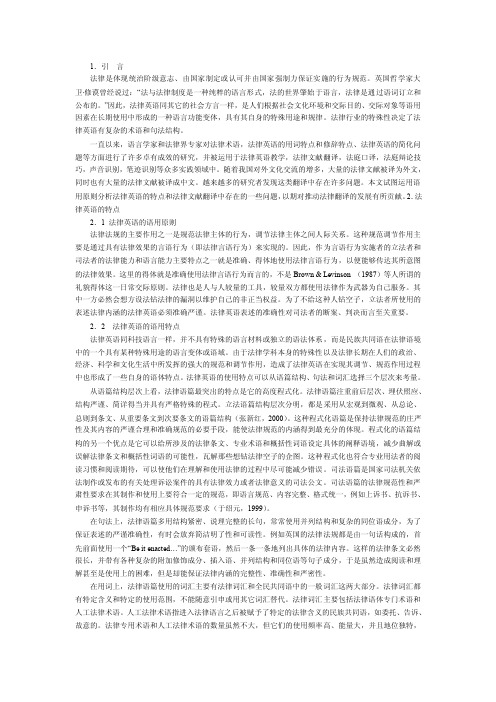
1.引言法律是体现统治阶级意志、由国家制定或认可并由国家强制力保证实施的行为规范。
英国哲学家大卫·修谟曾经说过:“法与法律制度是一种纯粹的语言形式,法的世界肇始于语言,法律是通过语词订立和公布的。
”因此,法律英语同其它的社会方言一样,是人们根据社会文化环境和交际目的、交际对象等语用因素在长期使用中形成的一种语言功能变体,具有其自身的特殊用途和规律。
法律行业的特殊性决定了法律英语有复杂的术语和句法结构。
一直以来,语言学家和法律界专家对法律术语,法律英语的用词特点和修辞特点、法律英语的简化问题等方面进行了许多卓有成效的研究,并被运用于法律英语教学,法律文献翻译,法庭口译,法庭辩论技巧,声音识别,笔迹识别等众多实践领域中。
随着我国对外文化交流的增多,大量的法律文献被译为外文,同时也有大量的法律文献被译成中文。
越来越多的研究者发现这类翻译中存在许多问题。
本文试图运用语用原则分析法律英语的特点和法律文献翻译中存在的一些问题,以期对推动法律翻译的发展有所贡献。
2.法律英语的特点2.1 法律英语的语用原则法律法规的主要作用之一是规范法律主体的行为,调节法律主体之间人际关系。
这种规范调节作用主要是通过具有法律效果的言语行为(即法律言语行为)来实现的。
因此,作为言语行为实施者的立法者和司法者的法律能力和语言能力主要特点之一就是准确、得体地使用法律言语行为,以便能够传达其所意图的法律效果。
这里的得体就是准确使用法律言语行为而言的,不是Brown & Levinson (1987)等人所谓的礼貌得体这一日常交际原则。
法律也是人与人较量的工具,较量双方都使用法律作为武器为自己服务。
其中一方必然会想方设法钻法律的漏洞以维护自己的非正当权益。
为了不给这种人钻空子,立法者所使用的表述法律内涵的法律英语必须准确严谨。
法律英语表述的准确性对司法者的断案、判决而言至关重要。
2.2法律英语的语用特点法律英语同科技语言一样,并不具有特殊的语言材料或独立的语法体系,而是民族共同语在法律语境中的一个具有某种特殊用途的语言变体或语域。
法律英语‘
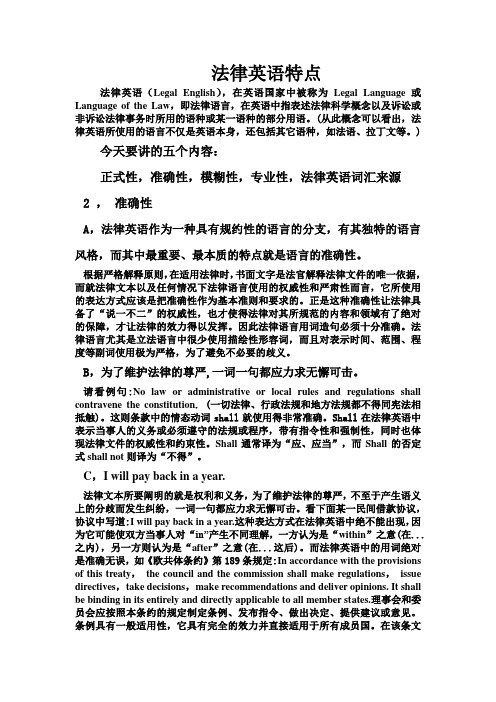
法律英语特点法律英语(Legal English),在英语国家中被称为Legal Language或Language of the Law,即法律语言,在英语中指表述法律科学概念以及诉讼或非诉讼法律事务时所用的语种或某一语种的部分用语。
(从此概念可以看出,法律英语所使用的语言不仅是英语本身,还包括其它语种,如法语、拉丁文等。
)今天要讲的五个内容:正式性,准确性,模糊性,专业性,法律英语词汇来源2 ,准确性A,法律英语作为一种具有规约性的语言的分支,有其独特的语言风格,而其中最重要、最本质的特点就是语言的准确性。
根据严格解释原则,在适用法律时,书面文字是法官解释法律文件的唯一依据,而就法律文本以及任何情况下法律语言使用的权威性和严肃性而言,它所使用的表达方式应该是把准确性作为基本准则和要求的。
正是这种准确性让法律具备了“说一不二”的权威性,也才使得法律对其所规范的内容和领域有了绝对的保障,才让法律的效力得以发挥。
因此法律语言用词造句必须十分准确。
法律语言尤其是立法语言中很少使用描绘性形容词,而且对表示时间、范围、程度等副词使用极为严格,为了避免不必要的歧义。
B,为了维护法律的尊严,一词一句都应力求无懈可击。
请看例句:No law or administrative or local rules and regulations shall contravene the constitution. (一切法律、行政法规和地方法规都不得同宪法相抵触)。
这则条款中的情态动词shall就使用得非常准确。
Shall在法律英语中表示当事人的义务或必须遵守的法规或程序,带有指令性和强制性,同时也体现法律文件的权威性和约束性。
Shall通常译为“应、应当”,而Shall的否定式shall not则译为“不得”。
C,I will pay back in a year.法律文本所要阐明的就是权利和义务,为了维护法律的尊严,不至于产生语义上的分歧而发生纠纷,一词一句都应力求无懈可击。
公文写作的语言风格
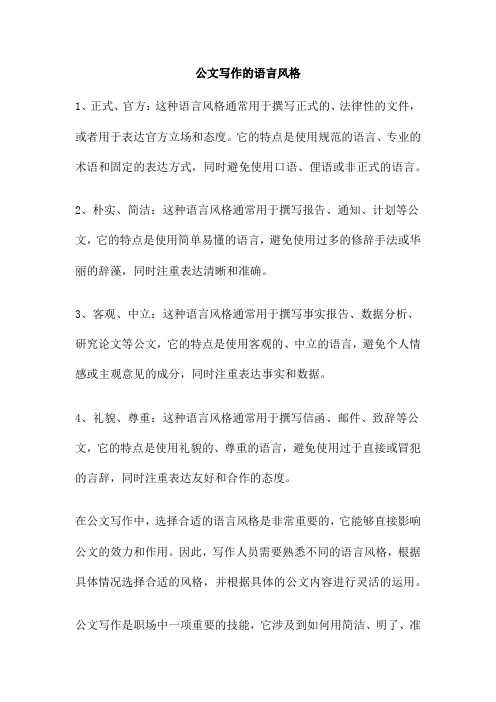
公文写作的语言风格1、正式、官方:这种语言风格通常用于撰写正式的、法律性的文件,或者用于表达官方立场和态度。
它的特点是使用规范的语言、专业的术语和固定的表达方式,同时避免使用口语、俚语或非正式的语言。
2、朴实、简洁:这种语言风格通常用于撰写报告、通知、计划等公文,它的特点是使用简单易懂的语言,避免使用过多的修辞手法或华丽的辞藻,同时注重表达清晰和准确。
3、客观、中立:这种语言风格通常用于撰写事实报告、数据分析、研究论文等公文,它的特点是使用客观的、中立的语言,避免个人情感或主观意见的成分,同时注重表达事实和数据。
4、礼貌、尊重:这种语言风格通常用于撰写信函、邮件、致辞等公文,它的特点是使用礼貌的、尊重的语言,避免使用过于直接或冒犯的言辞,同时注重表达友好和合作的态度。
在公文写作中,选择合适的语言风格是非常重要的,它能够直接影响公文的效力和作用。
因此,写作人员需要熟悉不同的语言风格,根据具体情况选择合适的风格,并根据具体的公文内容进行灵活的运用。
公文写作是职场中一项重要的技能,它涉及到如何用简洁、明了、准确的语言来表达思想和要求。
然而,很多人在公文写作中往往缺乏必要的语言知识,导致文章言不及义、表达不准确,甚至引起误解。
因此,为了提高公文写作的水平,我们需要加强语言知识的学习和运用。
首先,我们需要明确公文写作的主题。
每一篇公文都应该有一个明确的主题,这是文章的核心和灵魂。
在写作过程中,我们需要始终围绕这一主题展开,确保文章内容的一致性和连贯性。
接下来,我们需要认真考虑文章的引入部分。
引入部分是公文的开场白,它应该简明扼要地介绍所讨论的话题,并引出文章的主要内容。
好的引入能够引起读者的兴趣,使他们对接下来的内容产生期待。
在阐述主题时,我们要注意用准确、具体的语言来描述。
阐述部分是文章的主要内容,需要将主题展开并深入论述。
在写作过程中,我们要尽量避免使用模糊、含糊的语言,而是要用明确、具体的描述来传达思想。
法律英语的文体特点

法律英语是以英语共同语为基础,在立法和司法等活动中形成和使用的具有法律专业特点的语言。
因此,在法律英语中不仅有众多的具有法律专门意义的特殊词汇,而且由于规定人们权利和义务的法律、法令或契约等法律文书所表述的内容必须准确、严密、客观和规范,不容许丝毫的引伸、推理或抒发和表达感情,因而在法律英语中又形成了许多其特有的句法特点,这些词法和句法特点在翻译过程中必须受到充分重视。
下面我们从词汇、词类使用和句型结构三方面来考察法律英语的文体特点:1法律英语文体特点之一:法律英语词汇1.1法律英语用词特点:庄重、规范、书面语较多法律是掌握国家政权的阶级、集团的意志体现,它有鲜明的政策性,权威性。
为了维护法律的严肃性,法律、法规遣词造句力求准确,用词正式,语意严谨。
不像文学作品那样,有华丽的词藻和丰富的修饰语,也不可能使用比喻,夸张和委婉语气。
(1):This law is promulgated with the purpose of regulating insurance activities,protecting the legitimate rights and interests of the parties involved,strengthening supervision and regulation of the insurance industry and promoting its healthy development.(为了规范保险活动,保护保险活动当事人的合法权益,加强对保险业的监督管理,促进保险事业的健康发展,制定本法)[1](2):This Law is formulated for the purpose of standardizing negotiable instrument acts protecting the legal rights of parties concerned in negotiable instrument activities,maintaining the socialist market economy.(为了规范票据行为,保障票据活动中当事人的合法权益,维护社会经济秩序,促进社会主义市场经济的发展,制订本法。
法律英语的语言特征与翻译原则#

法律英语的语言特征与翻译原则----万法通学院法律英语,指表述法律科学概念及诉讼或非诉讼法律事务时所用的语体或该语体的部分用语,它是以英语共同语为基础,在立法和司法等活动中形成和使用的具有法律专业特点的语言。
因此,在法律英语中不仅有众多具有法律专门意义的特殊词汇,而且因为规定人们权利和义务的法律、法令或契约等法律文书所表述的内容必须准确、严密、客观和规范,不容许丝毫的引申、推理或抒发和表达感情,因而法律英语有其特有的风格,在翻译上也有其特有的方法和要求。
1 法律英语词汇特征及翻译法律语言的显著特点常常首先表现在词语的运用上。
Mellinkof 列出法律英语中词语使用的9 种情况: ①有法律专业意义的普通词;②来自古英语和中世纪英语的稀有词; ③拉丁词和短语; ④普通词汇中不包括的法语词; ⑤法律专业术语; ⑥专业行话; ⑦正式词语;⑧多义语; ⑨极端精确表达词语[1 ] 。
下面举例说明:1) 含有法律专业意义的普通词。
比如,action (诉讼) ,avoid(取消) ,consideration(对价) ,execute (签署) ,prejudice (损害) ,sae (除了,除⋯⋯外) ,sere (送达) ,said (上述,该) ,minor (未成年) 或major (已成年) ,instrument (法律文件) 等等。
2) 来自古英语和中世纪英语的稀有词。
古英语(OldEnglish) 是公元约1100 年以前的英语, 中古英语(Middle English) 则是公元约1100 年至1500 年间的英语。
这一点主要体现在大量使用以here , there 和where 与介词合成的词,比如, hereafter , herein , hereunder , hereafter , thereto , whereby ,万法通学院:wherein ,等等。
一些中古英语词语也较常用,比如, afore2said , witnesseth等。
- 1、下载文档前请自行甄别文档内容的完整性,平台不提供额外的编辑、内容补充、找答案等附加服务。
- 2、"仅部分预览"的文档,不可在线预览部分如存在完整性等问题,可反馈申请退款(可完整预览的文档不适用该条件!)。
- 3、如文档侵犯您的权益,请联系客服反馈,我们会尽快为您处理(人工客服工作时间:9:00-18:30)。
Linguistic and Stylistic Features of Legal English in T ranslationAbstractWith the quickening process of globalization of the world economy and after China‟s WTO accession, legal English, as a kind of professional English, is progressing rapidly in our country which is surely having more links with other countries in the world. Undoubtedly, there will be more and more legal documents that need to be translated. Legal English is a particular expressing mode and criterion formed gradually developed through a long process of judicial practice. To do well in the translation of English in law, it is crucial to understand its features. It has vivid features in words diction and sentence structure, and embodies the specialty, sobriety, preciseness and veracity of the legal language .This paper, from the point of linguistics and stylistics, analyses the present situation of legal English, elaborates the features of English in translation of legal documents and summarizes its major stylistic features: accuracy, vagueness and speciality. It reiterates the idea that translation of legal documents requires the grasp of its linguistic features so it also explores those linguistic features in a systematic way .Key words: linguistic featuresstylistic featureslegal Englishtranslation.1.Introduction“Legislative writing has acquired a certain degree of Notoriety rarely equaled by any other variety of English. It has long been criticized for its obscure expressions and circumlocutions,long-winded involved construction and tortuous syntax,meaningless repetitions and archaisms. To the specialist community these are indispensable linguistic devices which bring in precision,clarity,unambiguity and all- inc lusiveness and so on. However,to the non-specialist this is a mere ploy to promote solidarity between the members of the specialist community and to keepnon-specialists at a respectable distance and is hence regarded by them as nothing more than pure linguistic nonsense bringing into professional discourse pomposity, verbosity, flabbiness and circumlocution.”(Bhatia,1994:136)This is a judgement given by Vijay Bhatia about the linguistic features of legislative writings in the first paragraph of his works Cognitive Structuring in Legislative Provisions. It talks about both the specific and unique lexical and syntactic features of the legislative text and also how these linguistic features count from the specialists and non-specialists perspectives. In recent years,there has been a continual process of simplification of the legislative language in the English-speaking countries.However, despite these efforts at simplification and clarification, the gap between legislative text and everyday text is still very wide. Present day legislative text retains its identity as a highly specialized and distinctive text type or genre of English. The legislative texts of the legal systemsof England, Canada, the United States of America, Australia and New Zealand, which are derived from the English common law system, are manifestly similar. (Maley,1994:13) And now, deliberate discussion on the lexical as well as syntactic features of the legislative language will be given in the following part with an aim to guide the translation of this type of legal texts.2.Lexical Features of Legal EnglishArchaic relics,including archaism,French and Latin expressions,are retained in English legislative texts to achieve precision. Also,it is there out of the convention left by the long history of English law. The institution of English law dated from the Norman Conquest. The Normans brought with them legal concepts and procedures,and thus the institution was established. The written language of the law after the Conquest was at first Latin and English. Later,Latin gained ground steadily and became the predominant language in law. And the Latin then in the institution,was not classical or Medieval Latin,but a variety of Latin which included many Latinizied English and Old French words. By the fourteenth century,French became the language of law. And it is not until 1650,by An Act for Turning the Books of the Law,and all processes and proceedings in Courts of Justice into English(455(1650) 11 Acts and Ordinances or the Interregnum) that English became the official language of the law. By that time,Old English(archaism),Latin,Nomran-French and Middle English terms got fixed in the vocabulary of law. Over the cenutries,there has been a continual process Anglicisation,but in vocabulary,particularly in the specialized,technical lexicon,the law,the effect of its varied origins is still apparent. (Maley,1994:11-13) And now,let‟s see some of the archaisms, words with Latin and French origins, technical terms and official words retained in the legislative texts.ArchaismFrequent use of archaic words is one of the most remarkable featuers of legal language. Archaisms are the set of words used in the period 450-1100 AD,and the period 1100-1500 AD (Li,2003:17) and seldom appear in modern English,especially in the modern oral English. But they do remain in the legislative texts in light of the correctness and conservation of legislative language. Mellinkoff gave some archaisms that he considered to be the“daily bread”for the lawyers and“exposed to most non-lawyers on infrequent occasions”(1963:13): aforesaid and forthwithhere words: hereafter,herein,hereof,heretofore,herewithlet,as in the law tautology,without let or hindrancesaid and such as adjectivesthere words: thereabout, thereafter, thereat, thereby, therefore, therein, thereon, thereto, theretofore, thereupon, therewithwherewords, especially whereas used in recitals, and whereby witness, in the sense of testimony by signature, oath, etc., as in “ In witness whereof, I have set my hand, etc.”witnesseth, meaning to furnish formal evidence of something, the Old English present indicative, third person singular verb form.These words help ensure the accuracy and formalness of the legal texts.Loan wordsWith the expansion of international exchanges and the accelerated trends of globalization,acountry will more or less be influenced by the outside world, so wll the language of the nation. The borrowing of“loan words” is a process in which both form and meaning are borrowed with only a slight adaptation to the phonological system of the new language in some cases. Legal English has used some words that have been borrowed from Latin,French,etc.Words with Latin originLatin first permeated into English in 597 AD,and intermingled by large amount with English in the field of law,in the archaism period of the 14th and 15th AD (Li,2003:17). And since then,lots of English words with Latin sources remain in legal English,some of which are listed in the following table:affirm(断言) veto(否决)appeal(上诉) immune(免除的)offence(犯罪) verdiet(裁决)injury(伤害) litigant(诉讼人)legal(合法的) register(注册)custody(拘留) orbiter(仲裁人)suppress(镇压) testimony(证词)detention(拘留) negotiate(谈判)homicide(杀人) Convict(宣告)declaration(宣言) prosecute(对…起诉)compensate(补偿) appellate(受理上诉的) There are also Latin words retained in the legislative texts. Here is a list of Latin words basic to legislative texts:jus retentiouis(留置权) per stirpes(代位继承)obligatio solidaria(连带债务) confide jussio(共同保证)words with French originSince 1154,Britain had been reined by France in the House of Plantagenet and French became the official language,widely used in palace, courts and schools. Lots of English words with French origins are reserved in the legislative texts today,such as:bill(法案) petition(请愿)suit(诉讼) summon(传票)plea(抗辩) eyre(巡回法庭)inquest(审讯) defendant(被告)assize(巡回审判) attorney(律师)complaint(控告) advocate(辩护者)plaintiff(原告) judge(审判员,法官)bar(法庭,审判台) hue and cry(通缉令)indictment(告发,控告)Technical termsLots of legal technical terms are used in legislative texts out of the requirement for the correctness and clearness of the legal concept. And there are usually two kinds of technical terms in legislative language: the first type is technical terms employed to express the concept ofcommon-core language in daily life; the second type is common-core vocabulary in daily life borrowed to define specific legal meanings in legal language. The former includes words like: tort(侵权) subrogation(代位权)certiorari(上级法院向下级法院或准司法机构调取案卷的令状),while the latter contains the words like:average(海损) minor(未成年人)omission(不作为) review(复审)limitation(诉讼实效) precedent(判例,先例)affirmance(上级法院维持对下级法院的判决)official wordsColloquial language is seldom used in legislative texts,and aggregation of big words and written language is one of the characteristics of legislative texts.There are many examples to demonstrate this point:Terminated-end purchase-buyRender-make proceed-gorequest-task prior-earlierdesist-stop employ-useamiable-friendly present-givedemonstrate-show commence-beginThe words on the left side of these groups are official words used in legislative texts,while the words on the right side of these groups having exact meanings with the words on the left,but being more colloquial and informal words used more in daily language.Use of synonymsAs the function of legislation is conferring rights and imposing obligations, the use of synonyms helps make the denotation clearer and more precise. Generally speaking,synonyms cannot be replaced by each other in legal English. The difference between“misstatement”and “misrepresentation” is a good illustration of this point. For example,the directors of a company invited a loan from the public and stated that the money would be used to improve the comp any‟s buildings and to extend the business. The real intention of the directors was to use the money to pay off the comp any‟s debts.In this case,is the statement of the directors to the public called “misstatement”or “misrepresentation”? It depends on the fact whether or not the public has made a contract with the company. If so,“mispresentation”should be used. If not,“misstatement”should be used instead.3.Syntactic Features of Legal EnglishBesides lexicon,the syntactic structure of the legislative language is also unique. Unlike syntactic structures in other texts, complex-prepositions, binomial and multinomial expressions, nominalization,a large number and variety of qualifications are used in legislative texts. “The reason for this complexity appears to be that legislative is often trying to cover all possible combinations of conditions and contingencies. Language complexity increases greatly when an attempt is made to unify all these within the confines of a single sentence.”(John,1994:7) These Complicated syntactic features create barriers to effective understanding of legislative texts,yetgreatly to the clear,unambiguous and all-inclusive features of legislative texts. The following are syntactic features of legislative texts.3.1 Use of long complicated sentencesIn order to avoid misunderstandings and disputes,legal drafts sometimes have to arrange a lot of relevant information in different respects into the same sentence,thereby producing a prevalent phenomenon of long complicated sentences in legal texts. It is common to see a passage or an article that contains only one sentence,which asks for the legal translators‟logical and clear understanding of all constituents of the sentence. Sometimes it is up to legal translators to put the long complicated sentences into compound sentences with objective clauses, adverbial clauses or attributive clauses for a well-ogranized and clear statement. Look at the follownig examples:1)Chinese Original V ersion:第二十四条国家基于下列原因之一,可以限制国际服务贸易:(一) 为维护国家安全或者社会公共利益;(二)为保护生态环境;(三)为建立或者加快建立国内特定的服务行业;(四)为保障国家外汇收支平衡;(五)法律、行政法规规定的其他限制。
